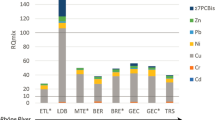Abstract
Purpose
Contaminated marine sediment can be treated to satisfy the concentration-based chemical criteria, but the treated sediment could still not be appropriate for reuse. This study used ecotoxicity tests to determine the reusability of treated marine sediment on terrestrial land.
Materials and methods
Changes in the toxicity of sediment contaminated with a mixture of total petroleum hydrocarbons (TPH) and heavy metals after treatment were investigated using both terrestrial (earthworm and wheat) and aquatic organisms (Daphnia magna, Allivibrio fischeri).
Results and discussion
The contaminant concentrations were reduced to meet the remedial goal of this study. As a result, the toxic effects on the tested organisms were reduced. The toxic effects of the reference sediment sample (RSS) that represents the background sediment toxicity were greater on wheat and earthworms than the treated sediment samples (TSSs). This was attributed to factors such as salinity and sediment texture. By comparing the toxicities of the sediment samples with that of the RSS, it was found that not only the contaminant concentrations, but also the sediment physicochemical properties such as pH, salinity, particle size distribution, and nutrient contents need to be considered from the step when the treatment processes are selected.
Conclusions
In conclusion, different aspects of the treated marine sediment quality, apart from the level of contaminants regulated, could be tested using ecotoxicity tests to determine the reusability of the treated marine sediment on land.


Similar content being viewed by others
References
Balkaya M (2019) Beneficial use of dredged materials in geotechnical engineering. In: Balkaya N, Guneysu S (eds) Recycling and reuse approaches for better sustainability. Environmental Science and Engineering. Springer, Cham, pp 21–38
Benvenuti S (2003) Soil texture involvement in germination and emergence of buried weed seeds. Agron J 95:191–198
Campisi T, Abbondanzi F, Casado-Martinez C, DelValls TA, Guerra R, Iacondini A (2005) Effect of sediment turbidity and color on light output measurement for Microtox® basic solid-phase test. Chemosphere 60:9–15
Cheng SF, Huang CY, Tu YT (2011) Remediation of soils contaminated with chromium using citric and hydrochloric acids: the role of chromium fractionation in chromium leaching. Environ Technol 32:879–889
Cuong DT, Obbard JP (2006) Metal speciation in coastal marine sediments from Singapore using a modified BCR-sequential extraction procedure. Appl Geochem 21:1335–1346
Dia M, Ramaroson J, Nzihou A, Zentar R, Abriak NE, Depelsenaire G, Germeau A (2014) Effect of chemical and thermal treatment on the geotechnical properties of dredged sediment. Procedia Engineer 83:159–169
Fabbricino M, Ferraro A, Luongo V, Pontoni L, Race M (2018) Soil washing optimization, recycling of the solution, and ecotoxicity assessment for the remediation of Pb-contaminated sites using EDDS. Sustainability 10:636
Goh BPL, Chou LM (1997) Heavy metal levels in marine sediments of Singapore. Environ Monit Assess 44:67–80
Gulshan AB, Dasti AA (2012) Role of soil texture and depths on the emergence of buried weed seeds. J Agr Biol Sci 7:223–228
Im J, Yang K, Jho EH, Nam K (2015) Effect of different soil washing solutions on bioavailability of residual arsenic in soils and soil properties. Chemosphere 138:253–258
Jho EH, Im J, Yang K, Kim YJ, Nam K (2015) Changes in soil toxicity by phosphate-aided soil washing: effect of soil characteristics, chemical forms of arsenic, and cations in washing solutions. Chemosphere 119:1399–1405
Kumar S, Sharma V, Bhoyar RV, Bhattacharyya JK, Chakrabarti T (2008) Effect of heavy metals on earthworm activities during vermicomposting of municipal solid waste. Water Environ Res 80:154–161
Luciana R, Ulises R, Susana G, Horacio T, María GA (2014) Effect of metals on Daphnia magna and cladocerans representatives of the Argentinean Fluvial Littoral. J Environ Biol 35:689–697
Madrid F, Diaz-Barrientos E, Madrid L (2008) Availability and bio-accessibility of metals in the clay fraction of urban soils of Sevilla. Environ Pollut 156:605–610
Nandula VK, Eubank TW, Poston DH, Koger CH, Reddy KN (2006) Factors affecting germination of horseweed (Conyza canadensis). Weed Sci 54:898–902
Owojori OJ, Reinecke AJ, Rozanov AB (2008) Effects of salinity on partitioning, uptake and toxicity of zinc in the earthworm Eisenia fetida. Soil Biol Biochem 40:2385–2393
Parida AK, Das AB (2005) Salt tolerance and salinity effects on plants: a review. Ecotox Environ Safe 60:324–349
Pelletier D, Sacks VP, Sorensen M, Magar V (in press) Review of remediation goals at contaminated sediment sites in the United States. Integr Environ Assess Manag. https://doi.org/10.1002/ieam.4162
Sujetovienė G, Žaltauskaitė J, Gintarė G (2011) Effects of salinity on earthworm (Eisenia fetida). In: environmental engineering: 8th international conference, may 19–20, 2011, Villnius, Lithuania: selected papers. Vol. 1: environmental protection. Vilnius: Technika, 2011
Tozzi F, Pecchioli S, Renella G, Melgarejo P, Legua P, Macci C, Doni S, Masciandaro G, Giordani E, Lenzi A (in press) Remediated marine sediment as growing medium for lettuce production: assessment of agronomic performance and food safety in a pilot experiment. J Sci Food Agric. https://doi.org/10.1002/jsfa.9815
Valdés-Rodríguez OA, Sánchez-Sánchez O, Pérez-Vázquez A (2013) Effects of soil texture on germination and survival of non-toxic Jatropha curcas seeds. Biomass Bioenergy 48:167–170
Vidonish JE, Zygourakis K, Masiello CA, Sabadell G, Alvarez PJ (2016) Thermal treatment of hydrocarbon-impacted soils: a review of technology innovation for sustainable remediation. Eng 2:426–437
Wuana RA, Okieimen FE (2011) Heavy metals in contaminated soils: a review of sources, chemistry, risks and best available strategies for remediation. ISRN Ecol 2011:402647
Zheng ZJ, Lin MY, Chiueh PT, Lo SL (2019) Framework for determining optimal strategy for sustainable remediation of contaminated sediment: a case study in Northern Taiwan. Sci Total Environ 654:822–831
Funding
This study was funded by the National Research Foundation of Korea [NRF-2018R1C1B6002702]. This study was supported by Hankuk University of Foreign Studies [2019].
Author information
Authors and Affiliations
Corresponding author
Additional information
Responsible editor: Jos Brils
Publisher’s note
Springer Nature remains neutral with regard to jurisdictional claims in published maps and institutional affiliations.
Electronic supplementary material
ESM 1
(DOCX 16 kb)
Rights and permissions
About this article
Cite this article
Jho, E.H., Yun, S.H., Lee, S.J. et al. Use of ecotoxicity assessment for determining reusability of treated marine sediment on terrestrial land. J Soils Sediments 20, 2306–2315 (2020). https://doi.org/10.1007/s11368-020-02590-7
Received:
Accepted:
Published:
Issue Date:
DOI: https://doi.org/10.1007/s11368-020-02590-7




